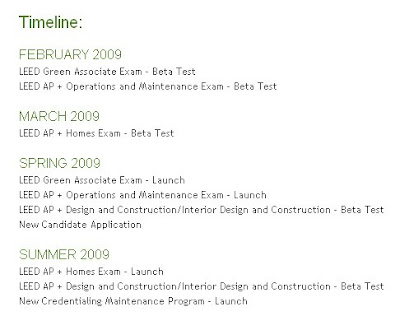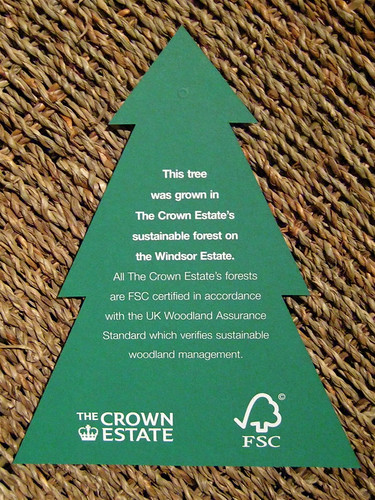Immediately following the "LEED 2009: Lift Off" presentation was one from the Green Buildings Certification Institute (GBCI) titled: "GBCI: Accreditation, Certification, and More." If the previous presentation was big on fluff and light on details, this one had me scrambling to keep up at my keyboard! Luckily, they posted a page that is uncommonly clear in listing dates for changes to occur!
Beth Holst, the Vice President Credentialing at GBCI, succinctly laid out the broad strokes of a completely revised, three-tiered accreditation system that I think is an enormously good idea! Before she started she did mention that 'legacy' LEED APs don't need to worry... "nothing is going to change for you." This is sort of a lie, but we'll get back to that later.
Tiered Credentialing
Instead of a one size fits all approach for each exam track, there is now going to be a flexible hierarchy of LEED accreditation that makes a whole lot of sense. A frequent complaint of the AP system is that it requires people to learn a lot of details that don't necessarily apply to they're everyday job. While it may be important for an architect to have detailed knowledge of every credit in the system, a contractor shouldn't be forced to memorize information about referenced standards for energy modeling or calculations for water efficiency. As a result, there is now a three tiered system:
Tier One - Green Associate
Many CEOs, marketing representatives, students, and other non-technical professionals are going to love this. The "LEED Green Associate" credential will test you only on the broad strokes of LEED... How does the LEED process work? Who needs to be involved at each stage? How do I know which rating system to use? Etc... This credential applies to all LEED systems. Once you earn this level of accreditation you can move on to the next stage:
Tier Two - LEED Accredited Professional
What was previously the only LEED AP designation is now the second tier. The basic idea is that this is where you would earn a specialized accreditation for each system. As Holst put it, "Homes are different... Neighborhood Development is really, really different", and there will be different tests for each rating system:
- Buildings Design and Construction (LEED-NC)
- Commercial Interiors Design and Construction (LEED-CI)
- Operations and Maintenance (LEED-EB)
- Homes (a new LEED-Homes track)
- Neighborhood Design (a new LEED-ND track)
Omitted in the presentation but listed on the website is a requirement that to become a LEED AP you must now also have some form of "professional experience on at least one LEED project." This will frustrate some people for sure, but I feel it's a good step forward.
Tier Three - LEED-AP Fellow
"We're going to take our time with this through the year." This was about the only information provided about the highest credential of Fellow. Holst was very clear that they want to take their time to develop an appropriately rigorous standard for fellowship, and that was about all we heard about this.
Code of Ethics
From a brief description, there is going to be a LEED AP Code of Ethics that all current AND future LEED APs will have to abide by. Most interesting about this announcement was that Holst hinted at some sort of peer enforcement system. Apparently there will be some avenue for people to tattle on their peers who aren't promoting sustainable design as they should. In the past the USGBC has essentially steered clear of policing its ranks, so it will be interesting to see how this develops in practice.
What You Really Want to Know - Timing of Exam Updates
Aside from the times listed below, I have it on good (but not rock solid) authority that the last day to register for the current LEED-NCv2.2 and LEED-CIv2.0 exams is going to be March 31st, with GBCI to cutoff administering exams sometime around June. This should give you plenty of time to study, take, and pass the current exams should you so choose, but you don't have much time to wait!

Straight from the GBCI Website
Credentialing Maintenance
"What do legacy LEED APs have to do? Nothing..." was what Holst said, but this ain't exactly true. With the new exams will come a new credentialing maintenance program. That's right, it's just another word for continuing education requirements... BLEH! Details are a little fuzzy, but the program works in two year blocks that will be consistent with the two year LEED revision cycle.
What you'll need to do every two years:
- Tier 1 Green Associate - 15 hours/two years - 3 LEED specific hours required
- Tier 2 LEED AP - 30 hours - 6 LEED specific
In addition to the fact that you have to do the continuing ed, you must also now pay a bi-annual maintenance fee of $50. Current LEED AP's will get the first FREE for first 2 years but will have to pay thereafter.
There's more to this than listed here, but I just wanted to hit on the high notes. Visit the GBCI page about the new system for more details. What do you think about the changes? Please let us know by leaving a comment.









